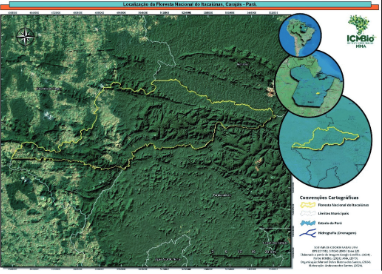Refinement of the geographical limits of the National Forest of Itacaiúnas, Marabá, Pará
DOI:
https://doi.org/10.37002/biodiversidadebrasileira.v15i1.2697Keywords:
Protected areas , creation decree , conservation unitAbstract
The process of verifying the spatial limits of a conservation unit, its location and design, can be influenced by a series of factors, however, if we consider the objectives for which these areas are created, it is essential that this verification is based on information the descriptive memorial, knowledge about the existing system of protected areas, information generated by other government entities and their insertion into the landscape. Most conservation units, once created, may contain distortions in the polygons, which do not invalidate the creation of the Unit, but which need to be corrected mainly when the intention is to implement these protected areas, such as demarcation. This step requires a more precise polygonal definition. The refinement of the polygon of the Itacaiúnas National Forest aimed to correct coordinate points that were not in accordance with the description contained in the descriptive memorial of the creation decree. The adjustments included all the points described, as there were large distortions in the location coordinates to be corrected, and in some points these distortions were greater. The inconsistencies analyzed in the FLONA Itacaiúnas polygon are considered systematic errors, corrected based on GIS simulations. It is important to highlight that during the work to refine the limits of FLONA Itacaiúnas, there was an effort to delimit easy-to-identify boundaries such as the use of natural or artificial boundaries such as: rivers, roads and municipal boundaries. The existence of these ends up facilitating the work of refining the perimeter of that unit.
Downloads
References
1. SNUC - Sistema Nacional de Unidades de Conservação, Lei 9.985 de 18 de julho de 2000; Ministério do Meio Ambiente.
2. https://educacao.uol.com.br/disciplinas/biologia/unidades-de-conservacao-caracteristicas-das-areas-de-protecao-integral.htm [Internet], [Acessado em 14/07/2024].
3. WWF - Brasil. Gestão de unidades de conservação: compartilhando uma experiência de capacitação. Maria Olatz Cases (org). WWF-Brasil/IPÊ – Instituto de Pesquisas Ecológicas:Brasília,2012. Disponivel em <https://d3nehc6yl9qzo4.cloudfront.net/downloads/gestao de unidades_de conservacao.pdf > Acesso em: 08/07/2024.
4. Milano MS. Unidades de Conservação – Técnica, Lei e Ética para a Conservação da Biodiversidade. In: BENJAMIN, Herman Antônio, (coord.). Direito ambiental das áreas protegidas: o regime jurídico das unidades de conservação. Rio de Janeiro: Forense Universitária, 2001.
5. Decreto n. 2.480, de 2 de fevereiro de 1998, Cria a Floresta Nacional do Itacaiunas, localizada no Município de Marabá no Estado do Pará.
6. Santos A. Nota Técnica nº 72/2023/CCOL/CGTER/DISAT/GABIN/ICMBio. DOI: https://doi.org/10.18356/9789211067484c014

Downloads
Published
Issue
Section
License
Copyright (c) 2025 Os autores mantêm os direitos autorais de seus artigos sem restrições, concedendo ao editor direitos de publicação não exclusivos.

This work is licensed under a Creative Commons Attribution-NonCommercial-NoDerivatives 4.0 International License.
Os artigos estão licenciados sob uma licença Creative Commons Atribuição-NãoComercial-SemDerivações 4.0 Internacional (CC BY-NC-ND 4.0). O acesso é livre e gratuito para download e leitura, ou seja, é permitido copiar e redistribuir o material em qualquer mídia ou formato.











